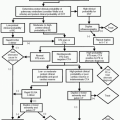Thoracolumbar Spine Trauma
David A. Weiland
Epidemiology.
Most thoracolumbar spine injuries occur as a result of motor vehicle accidents, although in the inner-city emergency room gunshot wounds are also very common. With the aging of the adult population, the frequency of compression fractures related even to minor trauma is also increasing.
Location.
Spinal fractures occur most frequently at C1-2, C5-7, and T12-L2. In the thoracolumbar spine, 60% of fractures occur between T12 and L2, with 90% between T11 and L4. The increased susceptibility of the thoracolumbar junction to trauma is thought to result from (1) loss of stabilization from the ribs and thoracic musculature, (2) change of thoracic kyphosis to lumbar lordosis, and (3) change in orientation of the facet joints from coronal to sagittal. In the pediatric population, there is a higher incidence of fractures in the midthoracic and upper lumbar spine.
Classification.
Flexion, compression, and shearing forces predominate in the thoracolumbar spine. The three-column classification system of Denis divides the spine into an anterior column consisting of the anterior longitudinal ligament and the anterior two thirds of the vertebral body and disc, a middle column comprising the posterior one third of the vertebral body and disc and the posterior longitudinal ligament, and a posterior column that includes the remaining posterior elements. Injuries involving more then one column are considered unstable.
A newer classification system has been proposed by Magerl to address some of the shortcomings of the Denis system. In this classification scheme, there are three types (A, B, and C) with subcategories within each group. Type A injuries include compression fractures of the vertebral body. Type B is a distracting injury resulting in disruption of two columns from either a hyperflexion or hyperextension type mechanism. Type C injuries involve a superimposed rotational component on a type B.
Mechanism.
The mechanism of injury is occasionally useful in predicting the type of spine injury. For example, a patient with a lap belt injury should be carefully evaluated for a possible Chance fracture; a patient with calcaneal fractures who jumped from a height should be examined for vertebral body compression fractures in the lower thoracic and lumbar spine. Upper thoracic spine trauma requires considerable force because of its inherent stability, and 17% of these injuries are associated with other noncontiguous spinal fractures. When injury does occur in this region, there is a very high incidence of associated spinal cord injury, which is probably related to the narrow spinal canal in the upper thoracic spine.
Complications.
Neurologic injury occurs in two thirds of burst fractures and three fourths of fracture-dislocations. Magnetic resonance imaging (MRI) is the best method for evaluation of cord injury, ideally performed within 24-48 hours of injury. Cord edema has a relatively good prognosis and demonstrates normal T1 signal and increased T2 signal. Cord hemorrhage has a poor prognosis and demonstrates abnormal signal of both T1 and T2 weighted images. Kummell’s disease is delayed posttraumatic vertebral body collapse. It can follow minimal trauma without overt fracture and is thought to be a form of avascular necrosis.
Differential Diagnosis.
Upper thoracic spine fractures can demonstrate mediastinal widening, an apical pleural cap, pleural effusion, paraparesis, or paraplegia—all of which are also seen with aortic transection.
Indications.
Radiographs are still the first line in the diagnosis of thoracolumbar trauma at most institutions. Obtaining good quality images can be a problem in an acutely injured patient, and the lateral spine views are notoriously difficult to obtain with the upper thoracic vertebrae almost always being obscured. Therefore, it is not unusual that the diagnosis is made on the basis of the anteroposterior (AP) films alone.
Possible Findings
Paraspinal soft tissue swelling.
Pleural effusion.
Abnormal kyphosis.
Posterior rib fractures.
Widening of the interpedicular distance.
Disruption or bulging of the posterior vertebral body line.
Anterior vertebral body wedging.
Indistinct endplates.
Loss of height of vertebral bodies and discs.
Increased or decreased distance between adjacent spinous processes.
Fractures through the pedicles on the AP view (Chance fracture).
Indications.
Computed tomography (CT) should be performed if there is any acute, trauma-related abnormality on the radiographs. CT should also be performed if the radiographs are negative when there is a high clinical suspicion due to the patient’s symptoms or signs. The sensitivity of CT in detecting unstable fractures varies between 97 and 100% whereas the sensitivity of plain radiographs is 33-57%.
Protocol.
Thin section images with multiplanar reconstructions are required for adequate evaluation of thoracolumbar spine. Bone windows (specific bone kernel reconstruction) for osseous injury and soft tissue windows should be reconstructed.




